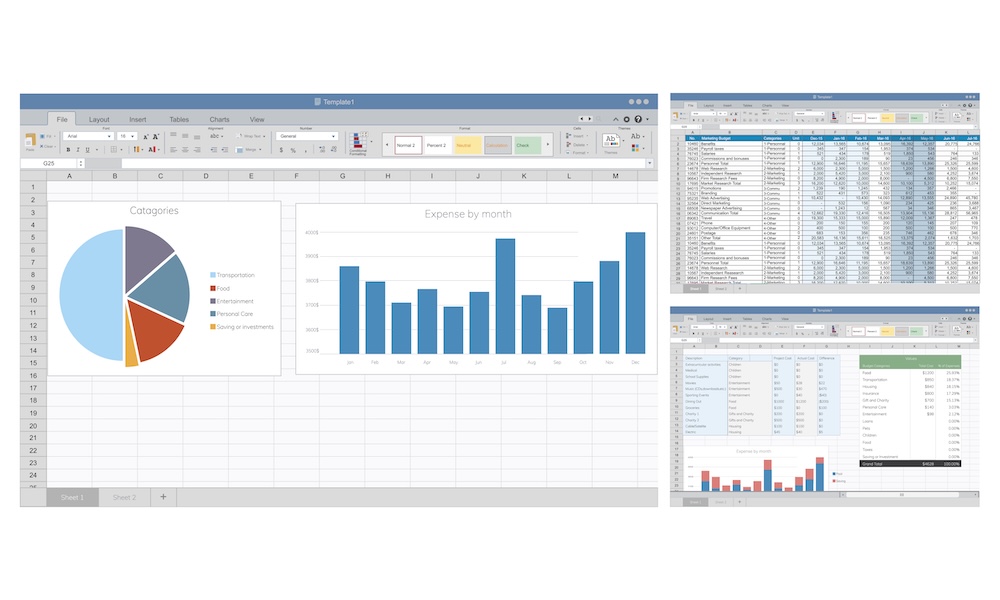For decades, Microsoft Excel has been the go-to tool for businesses managing data, tracking workflows, and generating reports. Its familiarity and flexibility have made it a staple in offices worldwide. Yet, as companies grow and operations become more complex, relying on manual Excel workflows can hinder efficiency, accuracy, and scalability. Many businesses continue using spreadsheets simply because they don’t realize how much time, money, and opportunity they’re losing by not upgrading to a custom web application.
The shift from Excel to a web app isn’t just about adopting new technology—it’s about transforming how businesses operate. Web applications eliminate repetitive tasks, reduce human error, and provide real-time insights that drive smarter decisions. For small and medium-sized enterprises (SMEs) looking to compete in a fast-moving digital economy, clinging to outdated processes could mean falling behind competitors who have already embraced automation.

Why Businesses Stick with Excel and What’s the Problem
Excel’s dominance in business operations isn’t surprising—it’s accessible, requires no coding knowledge, and can handle a wide range of tasks from budgeting to inventory tracking. Many companies, especially SMEs and startups, stick with Excel because it’s familiar and appears cost-effective at first glance. However, as operations expand, the limitations of spreadsheets become glaringly obvious.
The real issue isn’t Excel itself but the reliance on manual processes that come with it. Data must be entered by hand, formulas can break without warning, and version control becomes a nightmare when multiple team members work on the same file. What starts as a simple tracking tool quickly turns into a tangled web of inefficiencies that slow down business growth.

Why Manual Excel Workflows Are Holding You Back
Many businesses continue using Excel simply because "it’s always been done that way." However, what starts as a simple tracking tool often becomes a bottleneck as operations expand. Manual workflows in Excel introduce unnecessary risks in human errors, collaboration challenges, reporting delays, scalability issues, and security vulnerabilities. These inefficiencies drain time, increase costs, and limit growth potential.
Switching to a web app doesn’t just fix these problems, it redefines how businesses function. Automation replaces tedious data entry, real-time collaboration eliminates version conflicts, and cloud-based accessibility ensures teams work with the most up-to-date information. The longer companies delay this transition, the more they lose in productivity, accuracy, and competitive advantage.
1. Manual Workflows Create Delays and Errors
One of the most glaring issues with Excel-based workflows is their susceptibility to human error. Unlike automated systems, spreadsheets lack built-in validation checks, meaning mistakes in data entry, formula adjustments, or cell references can go unnoticed until they cause significant problems. A misplaced decimal point in financial reports, an accidental deletion in inventory logs, or a broken formula in sales projections can lead to costly discrepancies.
Real-World Scenario:
Consider a manufacturing company that tracks raw material orders in Excel. An employee accidentally overwrites a supplier’s delivery date, causing production delays. By the time the error is caught, the company faces rush-order fees and missed deadlines.
The Solution:
A web app automates data validation, ensuring entries follow predefined rules. Dropdown menus, auto-fill fields, and real-time alerts prevent incorrect inputs before they disrupt operations.
Benefit to Business:
Reducing manual errors means more reliable data, fewer operational hiccups, and improved decision-making. Businesses save time otherwise spent troubleshooting mistakes and gain confidence in their data accuracy.
2. Excel Isn’t Built for Teams
Excel’s single-user design makes teamwork cumbersome. While cloud-based versions like Excel Online allow multiple editors, conflicts arise when two users modify the same cell simultaneously. Shared spreadsheets often lead to version chaos, cause employees waste time reconciling different files or, worse, work with outdated information.
Real-World Scenario:
A sales team uses a shared Excel sheet to track leads. Two reps update the same prospect’s status without realizing it, causing duplicate follow-ups and client frustration.
The Solution:
A web app provides real-time synchronization, ensuring all team members see live updates instantly. Role-based permissions prevent unauthorized changes while maintaining transparency.
Benefit to Business:
Seamless collaboration eliminates confusion, speeds up workflows, and ensures everyone works from the same accurate dataset. Teams spend less time managing files and more time closing deals.
3. Reporting Takes Too Long (and Is Often Wrong)
Generating reports in Excel is a manual, time-intensive process. Employees must consolidate data from multiple sources, apply complex formulas, and format results, that consume hours each week. Even worse, if source data contains errors, reports will too, leading to misguided strategies.
Real-World Scenario:
A marketing agency compiles campaign performance metrics across 10 Excel sheets. A formula error skews ROI calculations, leading to overspending on underperforming ads.
The Solution:
A web app automates report generation with customizable dashboards that pull real-time data. Pre-built templates ensure consistency and accuracy.
Benefit to Business:
Instant, error-free reports empower faster, data-driven decisions. Teams reclaim hours previously wasted on manual compilation.
4. Excel Doesn’t Scale with Your Business
As businesses grow, so does their data volume. Excel files slow down, crash, or become unmanageable. Complex operations like multi-location inventory or customer relationship management will quickly outpace Excel’s capabilities.
Real-World Scenario:
A startup begins with 100 customers tracked in Excel. At 10,000 clients, the spreadsheet freezes constantly, delaying order processing.
The Solution:
A scalable web app handles increasing data loads effortlessly, with cloud storage ensuring smooth performance.
Benefit to Business:
Sustainable growth without technical bottlenecks, enabling businesses to focus on expansion rather than IT fixes.
5. Security Risks and Compliance Gaps
Excel files lack robust security. Shared via email or USB drives, they’re vulnerable to leaks, unauthorized edits, or accidental deletion. Sensitive data (e.g., payroll, customer info) stored in spreadsheets may violate compliance standards like GDPR.
Real-World Scenario:
An employee emails an Excel file containing client credit card details, which is intercepted in a phishing attack.
The Solution:
A web app encrypts data, enforces role-based access, and maintains audit logs for compliance.
Benefit to Business:
Reduced breach risks, regulatory compliance, and strengthened client trust.

Hidden Costs of Sticking with Excel
At first glance, Excel seems like a cost-effective solution with no upfront licensing fees, no training hurdles, and instant familiarity. But beneath the surface, manual spreadsheet workflows quietly drain your business of time, money, and opportunities. These hidden costs compound over months and years, eroding efficiency, stifling growth, and frustrating teams. Let’s break down where Excel is secretly costing you more than you realize.
1. Lost Productivity
Excel creates the illusion of control while stealthily stealing your team’s time. Employees waste hours each week on manual data entry, debugging corrupted files, or reconciling conflicting versions. A task as simple as updating inventory levels can spiral into a cross-departmental email chain just to verify numbers. These repetitive chores don’t just slow workflows, they divert attention from revenue-generating work. When your staff spends more time maintaining spreadsheets than innovating, productivity isn’t just lagging; it’s being held hostage.
2. Delayed Decisions
In today’s fast-moving markets, agility is everything. Yet Excel forces businesses to operate on outdated data. By the time someone exports, cleans, and formats information for a quarterly report, the insights are already stale. Sales teams miss real-time pipeline trends. Finance can’t spot cash flow gaps early. Leaders make critical calls based on yesterday’s numbers, or worse, guesswork. When competitors act on live dashboards, relying on manual reports is like driving with a foggy windshield.
3. Employee Burnout
Few things demoralize a team faster than battling broken spreadsheets. The constant stress of tracking down errors, recovering lost files, or explaining formula mistakes chips away at morale. Talented employees didn’t join your company to babysit cells and columns, as they want meaningful work. Over time, frustration leads to disengagement, higher turnover, and recruitment costs. Excel doesn’t just strain your operations; it exhausts your people.
4. Expensive Workarounds
Businesses often patch Excel’s gaps with costly Band-Aids: buying plug-ins, hiring consultants to build macros, or duct-taping integrations with other tools. These fixes create fragile ecosystems that collapse with updates or staff changes. One misplaced click can unravel months of work, forcing expensive emergency repairs. The irony? The cumulative "small fixes" often exceed the cost of a custom web app without ever solving the root problem.
5. Missed Opportunities
Every minute lost to spreadsheet maintenance is a minute stolen from growth. While your team reconciles invoices manually, competitors automate and scale. While they hunt for the latest sales figures, others leverage AI-driven insights. Excel’s hidden tax isn’t just financial, it’s the innovation you never pursue, the customers you don’t engage, and the markets you’re too bogged down to explore.

The Power of Web Applications: Transforming Business Operations
Web applications revolutionize how businesses operate by replacing manual, error-prone processes with automated real-time solutions. Unlike static spreadsheets, web apps offer dynamic collaboration, seamless scalability and instant data insights, turning operational bottlenecks into competitive advantages. For companies ready to move beyond Excel, custom web apps unlock efficiency, accuracy and growth potential that spreadsheets simply cannot match. Discover how this shift can modernize your workflows and propel your business forward in today's digital landscape.
Advantages Over Traditional Excel Workflows
Web applications don’t just improve Excel workflows, they reinvent them. Where spreadsheets rely on manual updates, web apps automate data collection and processing in real time, slashing errors by up to 90%. Teams collaborate simultaneously without version chaos, while live dashboards turn raw numbers into actionable insights at a glance. Reports that once took days to compile now generate themselves, freeing up hours for strategic work. It’s not just efficiency; it’s a fundamental shift in how businesses operate.
Flexibility and Customization for Specific Needs
Unlike rigid spreadsheets, web apps adapt to your business—not the other way around. Need a custom inventory alert? A client portal? Automated invoice approvals? Done. Web apps integrate seamlessly with tools like CRM systems, payment gateways, or ERP software, creating a unified workflow. And as your business scales, your app scales with it—no more outgrowing spreadsheets or wrestling with bloated files.
Industry Insights on Digital Transformation Benefits
The data is clear: companies that replace Excel with web apps see dramatic improvements. A 2023 study by Deloitte found businesses automating workflows reduced operational errors by 75% and accelerated decision-making by 40%. Leaders report stronger data security, easier compliance, and teams that spend 60% less time on repetitive tasks. In an era where agility defines success, web apps don’t just support growth, they fuel it.

Top Reasons to Transition from Excel to a Web App
Many businesses cling to Excel out of habit, unaware of how much it’s costing them in hidden inefficiencies. While spreadsheets work for basic tasks, they crack under the demands of modern business in wasting time, breeding errors, and stifling growth. Web applications don’t just replace Excel; they transform workflows with automation, collaboration, and scalability.
For startups and SMEs, this shift isn’t about luxury, it’s survival. Companies that migrate to custom web apps report 50% fewer errors, 3x faster processes, and scalability that grows with their ambitions. Below are the five most compelling reasons to make the switch today.
1. Enhanced Data Accuracy and Integrity
Web apps eliminate the "human error tax" of spreadsheets. Built-in validation rules block incorrect entries before they’re saved, so that no more misplaced decimals or broken formulas. Every action is logged in audit trails, creating a transparent record of who changed what and when. For finance teams, this means reconciling numbers in minutes, not days. For inventory managers, it ensures stock levels are always precise.
2. Improved Collaboration and Accessibility
Excel’s "File in Use" warnings become relics of the past. Cloud-based web apps let teams edit, approve, and analyze data simultaneously, whether they’re in the office or halfway across the world. Version control is automatic, and activity logs replace endless "Did you update the spreadsheet?" emails. Sales teams close deals faster with real-time CRM access, while managers monitor operations from any device.
3. Increased Efficiency and Time Savings
Automation transforms hours of grunt work into seconds. Invoices self-populate from orders. Reports generate with a click. Low-stock alerts trigger purchase orders automatically. One logistics company saved 20 weekly hours by replacing their Excel freight tracker with a web app, and reinvested the more time into customer service.
4. Better Data Security and Compliance
Spreadsheets shared via email are data breaches waiting to happen. Web apps encrypt sensitive information, restrict access by role (e.g., "View Only" for interns), and auto-backup daily. For industries like healthcare or finance, built-in compliance features (GDPR, SOC 2) turn audit nightmares into check-the-box formalities.
5. Scalability and Future-Proofing
Excel crashes at 1M+ rows. Web apps handle millions of records while staying lightning-fast. Adding users? Just create logins. Expanding services? Plug in new modules. A Malaysian e-commerce startup scaled from 100 to 10,000 orders/month without switching systems, as their custom app grew with them.
Cost-Benefit Comparison
While Excel appears free at first glance, its hidden costs are hours lost to manual work, expensive error corrections, and security risks add up quickly. In contrast, a custom web app requires an upfront investment but delivers measurable returns: near-zero data errors (vs. Excel’s error-prone workflows), tasks completed in minutes instead of hours, and enterprise-grade security replacing vulnerable spreadsheets. Businesses typically recoup costs within 6–18 months through productivity gains alone, not to mention the long-term advantages of scalability and competitive agility. The choice isn’t just about cost, it’s about whether you can afford not to upgrade.

How to Transition from Excel to a Web App Effectively
Transitioning from Excel to a web app streamlines workflows and boosts efficiency. Start by assessing needs, choosing the right development approach, and implementing in phases. Proper planning, partner selection, and team training ensure a smooth shift turning manual processes into automated, scalable solutions.
1. Planning and Requirement Gathering
Start by mapping the pain points of your current Excel workflow. Interview team members who use spreadsheets daily in finance, operations, sales, and document that make they frustrated. Is it version control issues? Slow reporting? Data errors? Prioritize features that will deliver the quickest wins, like automated data validation or real-time dashboards. A clear requirements list prevents scope creep and ensures your app solves actual problems, not hypothetical ones.
2. Selecting the Right Development Partner or Platform
When moving beyond Excel, you’ll face a critical choice: generic platforms or custom-built solutions. Here’s how to decide:
Option 1: Custom-Built Apps
For businesses with unique workflows or growth ambitions, tailored web applications are the gold standard. Unlike rigid templates, a custom solution:
- Fits your operations perfectly – No awkward workarounds for your inventory, CRM, or reporting needs.
- Scales seamlessly – Handles increased users/data without costly migrations.
- Integrates everything – Connects to your existing tools (accounting software, APIs, etc.).
Why CodeBudee? As a Malaysia-based specialist in SME tech solutions, we:
✔️ Build affordable MVPs for startups testing ideas
✔️ Modernize legacy processes for growing businesses
✔️ Provide ongoing support—you’re never left troubleshooting alone
Option 2: Low-Code Platforms
Best for: Simple apps with basic automation (e.g., form builders).
Limitations: Often can’t handle complex logic or high-volume data.
Option 3: No-Code Tools
Best for: Non-technical teams needing quick prototypes.
Risks: Vendor lock-in; limited customization as needs evolve.
The Smart Choice
While off-the-shelf tools seem cheaper upfront, custom apps (like CodeBudee’s) deliver long-term ROI by eliminating:
➔ Monthly subscription fees for multiple platforms
➔ Productivity losses from clunky workarounds
➔ Future redevelopment costs when you outgrow templates
Next Step: Book a free consultation to discuss your Excel pain points, we’ll outline a solution in plain language, no tech jargon.
3. Implementation and Training
Roll out in phases to avoid disruption. For example:
- Phase 1: Migrate core functions (e.g., inventory tracking) with a pilot team.
- Phase 2: Add advanced features (automated reporting) and onboard more users.
- Phase 3: Full launch with training workshops and cheat sheets.
Assign "app champions" in each department to drive adoption. Post-launch, collect feedback and iterate, your web app should evolve with your business.
Conclusion
Sticking with Excel may feel familiar, but it’s a silent growth inhibitor in today’s fast-paced digital landscape. Manual workflows drain productivity, introduce costly errors, and create unnecessary roadblocks for collaboration and scalability. The transition to a custom web app isn’t just an upgrade, it’s a strategic investment in efficiency, accuracy, and long-term business resilience.
At CodeBudee Solutions, we specialize in transforming outdated Excel processes into streamlined, automated web applications tailored to your unique needs. Whether you’re a startup looking to scale or an SME aiming to optimize operations, our solutions empower you to work smarter, not harder.
Don’t let spreadsheets hold your business back. Get in touch with us today for a free consultation, and let’s build a workflow that grows with your ambitions. The future of your business is just one click away. 🚀


